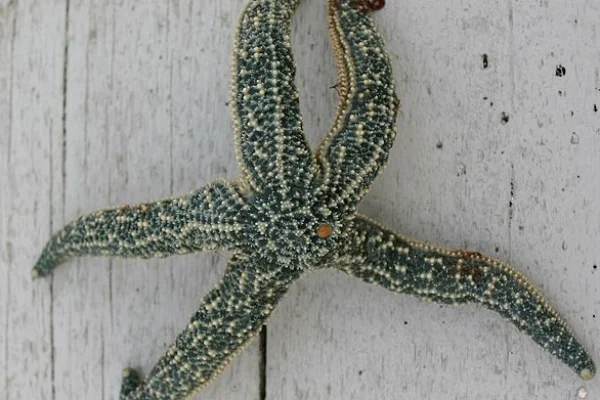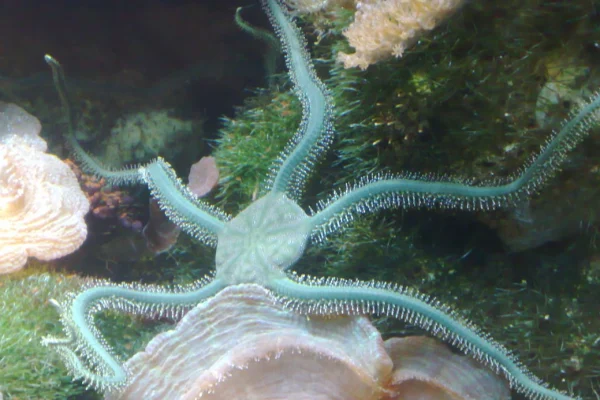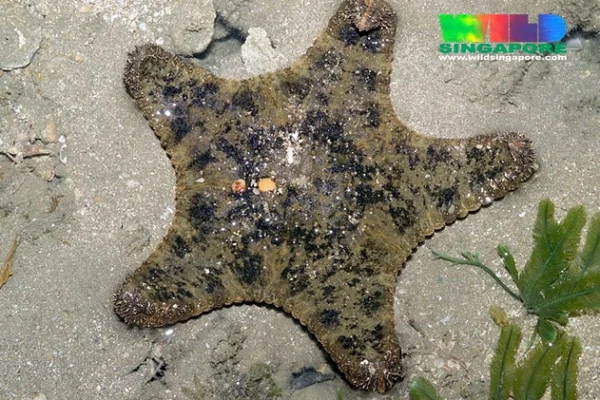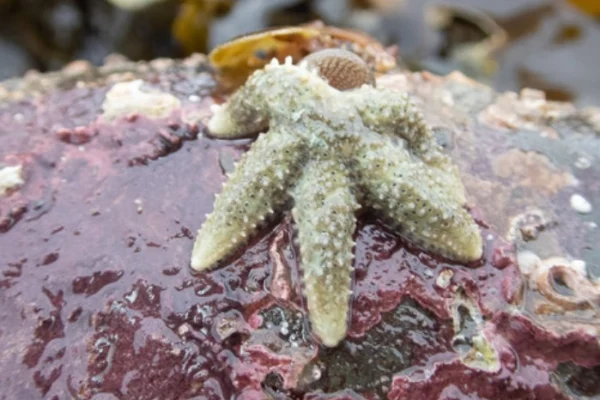The deep blue sea has so much treasure in it that you can’t even imagine. But today we together are going to spot them. If you think we are talking about gold, then you are wrong, because we are going to explore the beauty of nature in the ocean. Here we will spot some beautiful, cute green starfish that lay on the sea bed.
So that next time, whenever you make a trip to the seashore, you can easily identify a green starfish. Sometimes these green starfish are seen on the beaches. Here is the list of 15 green starfishes.
15 Green Starfish
1. Cushion star

| Scientific name | Culcita novaeguineae |
| Location | Indo-pacific region |
| Identification | Short arms |
Culcita novaeguineae, named cushion star cause of its appearance, looks like a pentagonal pincushion. This species of starfish can grow up to 30 cm. Do you know what makes its appearance like a cushion, its short arms?
The body wall of this sea star has calcareous ossicles filled with water and supported through pillars.
You can see these species in various colors such as fawn, brown, orange, yellow, green, and many more.
Their low profile gives them a unique identification. The space between their arms filled as they became adults.
2. Mottled Star

| Scientific name | Evasterias troschelii |
| Location | Kamchatka and the northwestern coast of North America |
| Identification | spines of calcareous plates cover the aboral surface |
Evasterias troschelii, also known as the mottled star, false ochre sea star, and Troschel’s real star, is a species of starfish in the Asteriidae family. Found in Kamchatka and along North America’s northwest coast.
The mottled star features a tiny disc with five long, thin arms and a huge radius of up to 28 cm. The top surface is rough to the touch, with a large ambulacral groove on the oral surface.
The color of the mottled star varies, including orange, brown, greenish-grey, bluish-grey, and pastel purple.
3. Green Linckia Sea Star
| Scientific name | Linckia guildingi |
| Location | Pacific Ocean, Indian Ocean, Atlantic Ocean, and Caribbean Sea |
| Identification | five cylindrical arm |
The common comet star got its scientific name as Linckia guildingi, and we’ll know it by other names such as Guilding’s sea star or green Linckia.
You can commonly find these sea stars in the water of the Pacific Ocean, Indian Ocean, Atlantic Ocean, and Caribbean Sea.
This cute, proper green starfish has a small disc with five cylindrical arms. The upper surface of the sea star is rough. Looking at the color variations, you can see these species in green, brown, blue, and dull red.
4. Green brittle star

| Scientific name | Ophiarachna incrassata |
| Location | pacific ocean and red sea |
| Identification | spiny arms |
The Green Brittle Starfish, also known as O. incrassata, is a unique and useful species with a muted green body and yellow highlights.
It typically has five long, spiny arms from its central disc and can reach a maximum adult size of around 10 inches.
5. Marthasterias
| Scientific name | Marthasterias glacialis |
| Location | Iceland, Macaronesia, North Atlantic, Angola, South Africa, and South Atlantic |
| Identification | whitish spines with purple tips |
Marthasterias is a monotypic genus of starfish, known as spiny starfish, native to the eastern Atlantic Ocean.
This large species has a small central disc and five slender, tapering arms with three longitudinal rows of conical, whitish spines with purple tips.
The background color is variable and can range from brownish to greenish-grey, with a yellow or red tinge at the tips. The species can grow up to 70 cm (28 in) but is usually 25 to 30 cm (10 to 12 in) in size.
6. Starlet cushion start
| Scientific name | Asterina gibbosa |
| Location | northeastern Atlantic Ocean and Mediterranean Sea |
| Identification | blunt spines on its upper surface |
Asterina gibbosa, also known as the starlet cushion star, is a pentagonal starfish native to the northeastern Atlantic Ocean and the Mediterranean Sea.
It has short, blunt arms and an inflated appearance, with short, blunt spines on its upper surface.
The starfish grows to about 5 centimeters and can be brown, green, or orange. Asterina gibbosa is considerably larger than A. phylactica, which rarely exceeds 15 mm.
7. Crown-of-thorns starfish
| Scientific name | Acanthaster planci |
| Location | Australia, the Red Sea, the East African coast, the Indian Ocean, the Pacific Ocean, and the west coast of Central America |
| Identification | full of spines |
The crown-of-thorns starfish is a unique species with a disc-shaped body, multiple arms, flexibility, prehensile, heavily spun, and a large ratio of stomach surface to body mass. Its prehensile ability is due to its two rows of numerous tube feet.
Adults range in size from 25 to 35 cm (10 to 14 in) and have up to 21 arms. The starfish can bend and twist to fit around coral contours, with each arm having a series of plates.
The species can be purple, purple-blue, reddish grey, brown, or green with red or yellow spine tips. The long, sharp spines on the sides of the arms and upper surface resemble thorns, creating a crown-like shape.
The general body surface is membranous and soft. When removed from the water, the starfish’s surface ruptures and body fluid leaks out, causing the body to collapse and flatten.
8. Sunflower sea star
| Scientific name | Pycnopodia helianthoides |
| Location | Puget Sound, British Columbia, northern California, and southern Alaska |
| Identification | larger body |
Sunflower sea stars, also known as Pycnopodia helianthoides, are large, carnivorous sea stars found in the northeastern Pacific Ocean. With a maximum arm span of 1 m, they are the heaviest known species, weighing about 5 kg.
Adult sunflower sea stars have 16 to 24 limbs and vary in color. They eat various types of prey and have a growth rate of 8 cm per year in the first few years of life and 2.5 cm/year later.
Their color ranges from bright orange, yellow-red, brown, and sometimes purple, with soft, velvet-textured bodies and powerful suckers.
9. Eight armed sea star
| Scientific name | Luidia maculata |
| Location | Indo-West Pacific region |
| Identification | pointed arms and a small central disc |
Luidia maculata is a large starfish with seven or eight-pointed arms and a small central disc. It has two color forms: uniform dark brown or greenish-brown, dark brown with orange-brown chevron-shaped markings, or light brown with dark markings.
This species of green starfish is an active, carnivorous sea star. It is one of the largest sea stars in Singapore, growing up to 60cm in diameter.
This species typically has eight arms, moves rapidly when submerged, and is more active at night. Found mainly in the Indo-West Pacific region, including Singapore.
10. Cake sea star

| Scientific name | Anthenea aspera |
| Location | North Australia, southern Japan, China, Indonesia, and Singapore |
| Identification | small starfish |
Cake sea stars are a rare species found in the Indo-Pacific, with a large, flat sea star with a diameter of 10–20 cm. They come in various colors, such as green, red, yellow, brown, etc., and patterns.
This species of starfish can easily be found on northern shores, seagrass meadows, and coral rubble. They are found on muddy sand in Australia and are more active during the day.
11. Six-rayed star
| Scientific name | Leptasterias hexactis |
| Location | United States |
| Identification | short mushroom-shaped spines |
Leptasterias hexactis is a starfish species in the Asteriidae family, known as the six-rayed star, found on the western seaboard of the United States. It is a predator and broods its eggs and young.
The aboral surface of the starfish varies in color, usually dark grey, brown, olive green, or brick red. It is densely clad with short mushroom-shaped spines, interspersed with pedicellariae. The oral surface is pale, with parallel rows of tube feet with suckers extending along the arms.
12. Northern starfish

| Scientific name | Leptasterias muelleri |
| Location | north-western Pacific Ocean, including Japan, Russia, North China, and Korea |
| Identification | longitudinally arranged spines |
Leptasterias muelleri is a small spiny starfish, typically 6 cm in diameter, with five medium-length arms and four rows of tube feet with sucking discs. It can be pink, violet, or green in color, with pale arm tips.
Green morphs are obtained through single-celled algae in the starfish’s upper tissue. The upper surface is covered by regular, longitudinally arranged spines, which are knob-shaped, especially on the mid-dorsal line.
The spaces between the spines are occupied by single papulae, soft projections of respiratory function. The species may have one or two rows of ambulacral spines on its ventral surface and two regular rows along the side of the arms.
13. Bat Star
| Scientific name | Patiria miniata |
| Location | U.S. Pacific coast, Alaska, San Diego, and Mexico |
| Identification | the center disk is wider than the stubby arms |
Patiria miniata, also known as the bat star, sea bat, webbed star, or broad-disk star, is a species of sea star in the Asterinidae family. It typically has five arms, with the center disk being wider than the stubby arms.
Bat stars can have up to nine arms and come in various colors like green, purple, red, orange, yellow, and brown. The name “bat star” comes from the webbing between its arms.
14. Carpet sea star
| Scientific name | Meridiastra calcar |
| Location | Australia |
| Identification | triangular arms |
Meridiastra calcar, also known as carpet sea star, cushion sea star, or eight-armed sea star, is a species of sea star found in Australia. It has eight distinct triangular arms, with some 7- or 9-armed individuals.
The aboral surface can be any color, while the oral side is uniformly pale. This species of starfish appears in various colors, like green, blue, yellow, and red, with different patterns on the surface. The species has a maximum diameter of 5 cm–10 cm from arm tip to arm tip.
15. Red cushion sea star
| Scientific name | Oreaster reticulatus |
| Location | Bahamas, Cape Frio, Cape Hatteras, the Caribbean Sea, Florida, the Gulf of Mexico, and Guyanas |
| Identification | upper surface covered with blunt spines |
Oreaster reticulatus, also known as the red cushion sea star or West Indian sea star, is a marine invertebrate in the Oreasteridae family found in shallow water in the western Atlantic Ocean and Caribbean Sea.
It is the largest sea star within its range, sometimes growing up to 50 centimeters in diameter. The red cushion star has five broad arms projecting from a cushioned disc, with a hard upper surface covered with blunt spines.
Adults are red, orange, yellow, or brown, while juveniles are greenish-brown with mottled markings.
Conclusion:
Today, we explore the beautiful world of these green starfish species. As we look, these starfish have beautiful tones of green, some have yellowish green, some have grey, and some have olive green.
How do you feel about these amazing green starfish? Well, these species are another example of nature’s creativity.
However, we end our adventure here today, but don’t worry, because this is not the end of our journey. We will be back. Till then, stay tuned with us on HowItSee.
FAQs:
1. What is the scientific name of the Cushion star?
Ans: Culcita novaeguineae is the scientific name of Cushion star.
2. Where can you find the Mottled Star?
Ans: Kamchatka and the northwestern coast of North America are the regions where Mottled star is founded.
3. Which ocean is the Green Linckia Sea Star commonly found in?
Ans: Pacific Ocean, Indian Ocean, Atlantic Ocean, and Caribbean Sea are the oceans were Green Linckia sea star are commonly found.
4. What is unique about the Green Brittle Star’s body color?
Ans: Muted green body with yellow highlights differentiate Green brittle star from other.
5. Where is Marthasterias, the spiny starfish, native to?
Ans: Iceland, Macaronesia, North Atlantic, Angola, South Africa, and South Atlantic are the native region of Spiny starfish.
6. What distinguishes the Starlet Cushion Star?
Ans: Blunt spines on its upper surface is the unique feature of Starlet Cushion star.
7. In which regions can you find the Crown-of-thorns starfish?
Ans: Crown of throns starfish are the commonly found in Australia, the Red Sea, the East African coast, the Indian Ocean, the Pacific Ocean, and the west coast of Central America.
8. What is the distinctive feature of the Sunflower sea star?
Ans: Sunflower sea star has a larger body with 16 to 24 limbs.
9. Where is the Eight Armed Sea Star mainly found?
Ans: Eight armed sea star mainly found in Indo-West Pacific region, including Singapore.
10. Where can you find Cake Sea Stars?
Ans: Cake sea stars are commonly found in North Australia, southern Japan, China, Indonesia, and Singapore.
11. What characterizes the Six-rayed Star?
Ans: Six rayed star has a short mushroom-shaped spines on the aboral surface.
12. Where is the Northern Starfish found?
Ans: Norther starfish are commonly found in Northwestern Pacific Ocean, including Japan, Russia, North China, and Korea.
13. What makes the Bat Star distinctive?
Ans: Center disk wider than the stubby arms.
14. Which country is home to the Carpet Sea Star?
Ans: Australia is the region where Carpet sea star are commonly found.
15. What is the maximum diameter of the Red Cushion Sea Star?
Ans: The red cushion sea star grows up to 50 centimeters.
References:
- https://en.wikipedia.org/wiki/Meridiastra_calcar
- https://en.wikipedia.org/wiki/Patiria_miniata
- https://www.marlin.ac.uk/species/detail/2193
- https://en.wikipedia.org/wiki/Leptasterias_hexactis
- http://www.wildsingapore.com/wildfacts/echinodermata/asteroidea/anthenea.htm
- https://www.jungledragon.com/image/97495/luzon_sea_star-_echinaster_luzonicus.html
- https://en.wikipedia.org/wiki/Asterina_gibbosa
- https://en.wikipedia.org/wiki/Marthasterias
- https://www.tankstop.com/inverts/starfish/green-brittle-starfish-ophiarachna-incrassata/
- https://en.wikipedia.org/wiki/Evasterias_troschelii
- https://en.wikipedia.org/wiki/Oreaster_reticulatus
- https://en.wikipedia.org/wiki/Culcita_novaeguineae
Also Read:

As a content writer, I like to write about different niches. I have a curiosity about nature and animals. And like to learn about them. Through my writing, I like to share my experience and knowledge with you. I hope you are enjoying it too.
